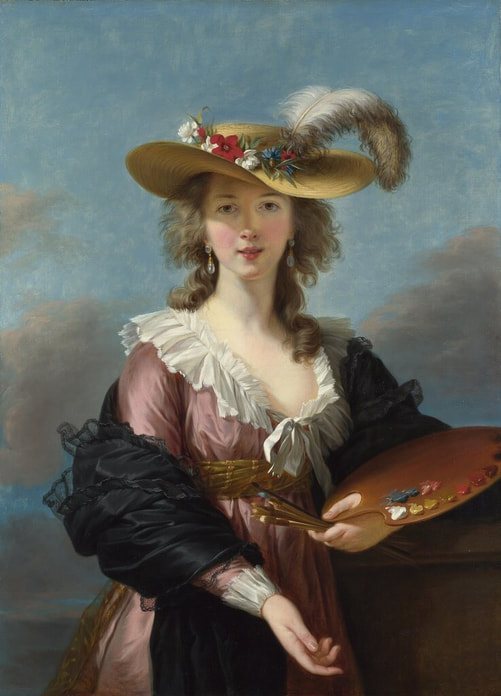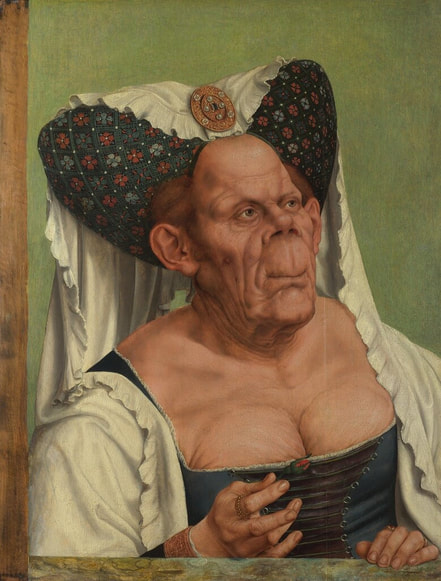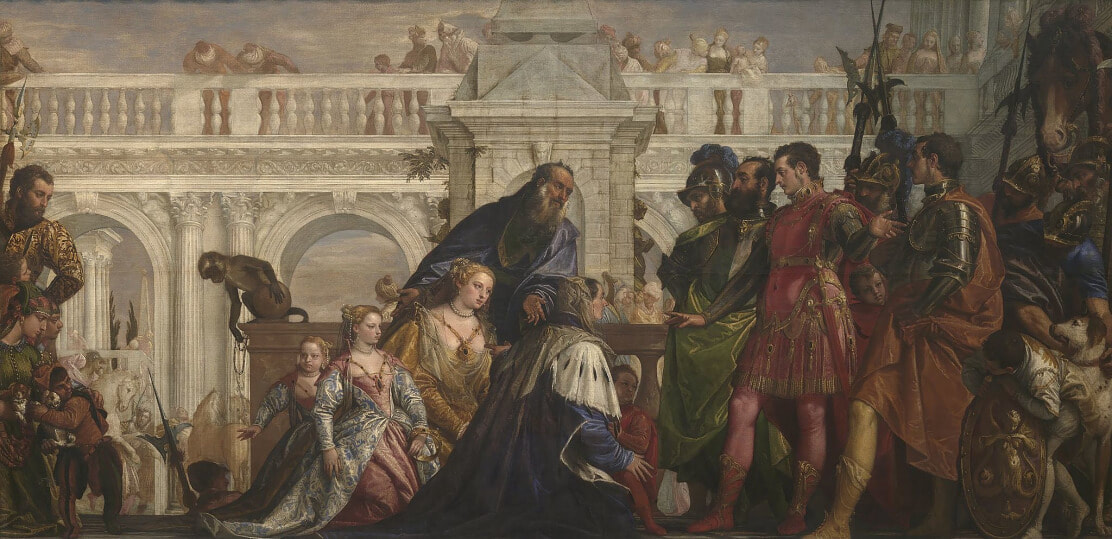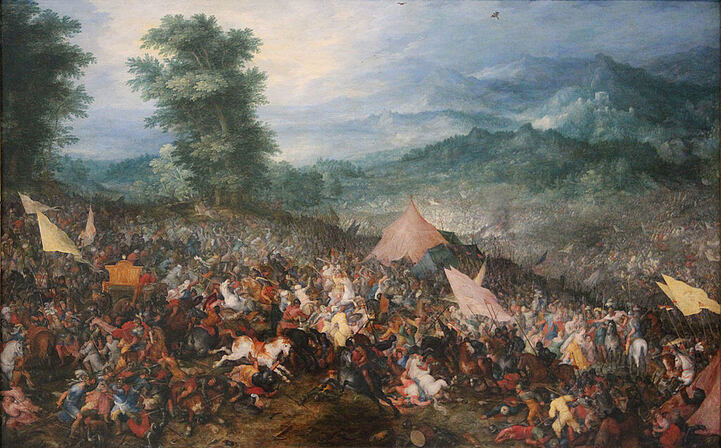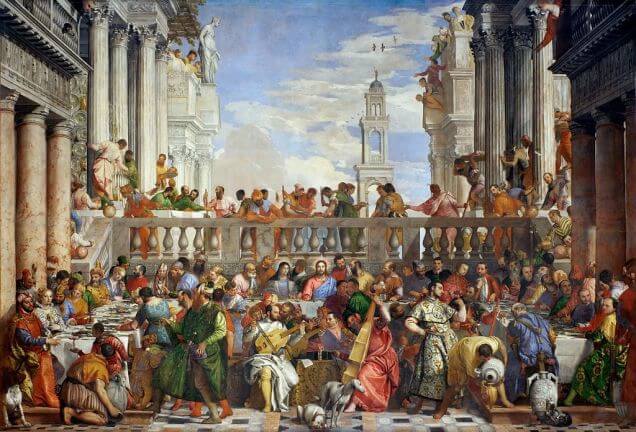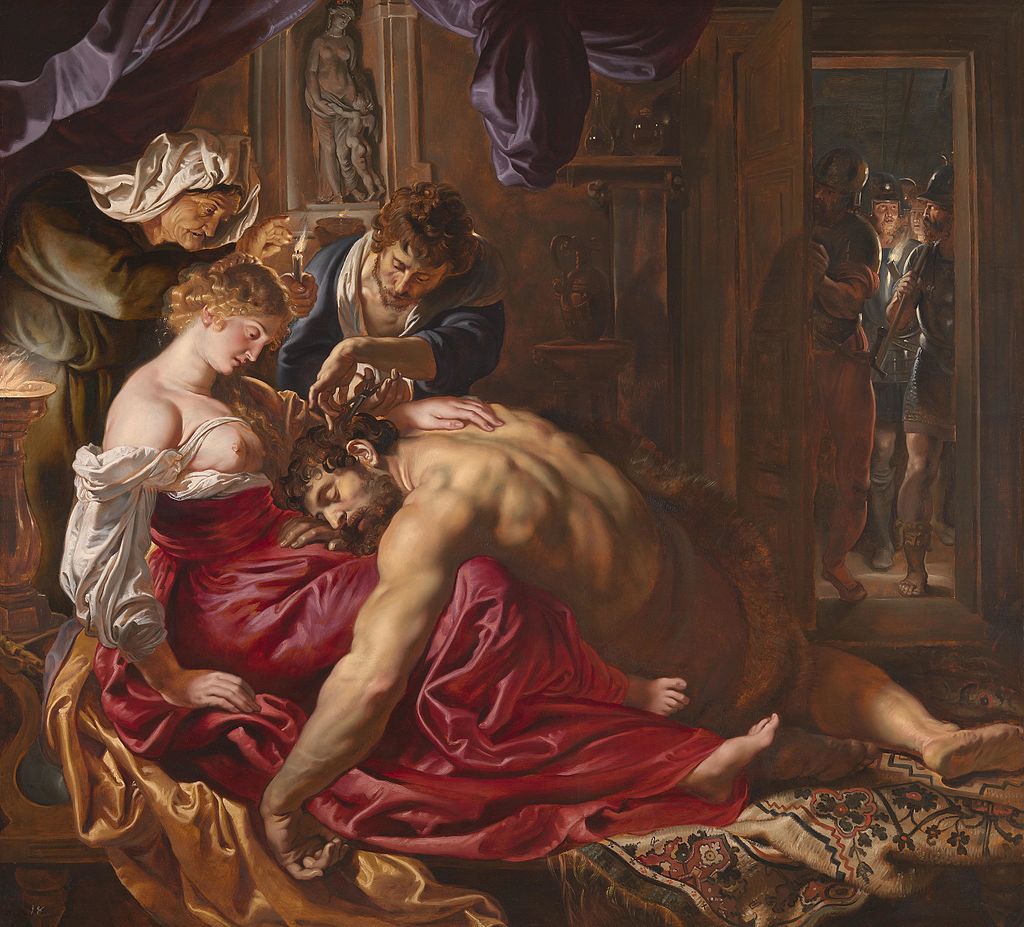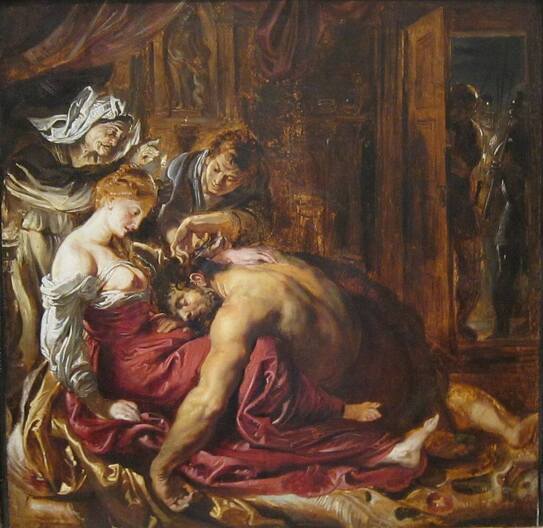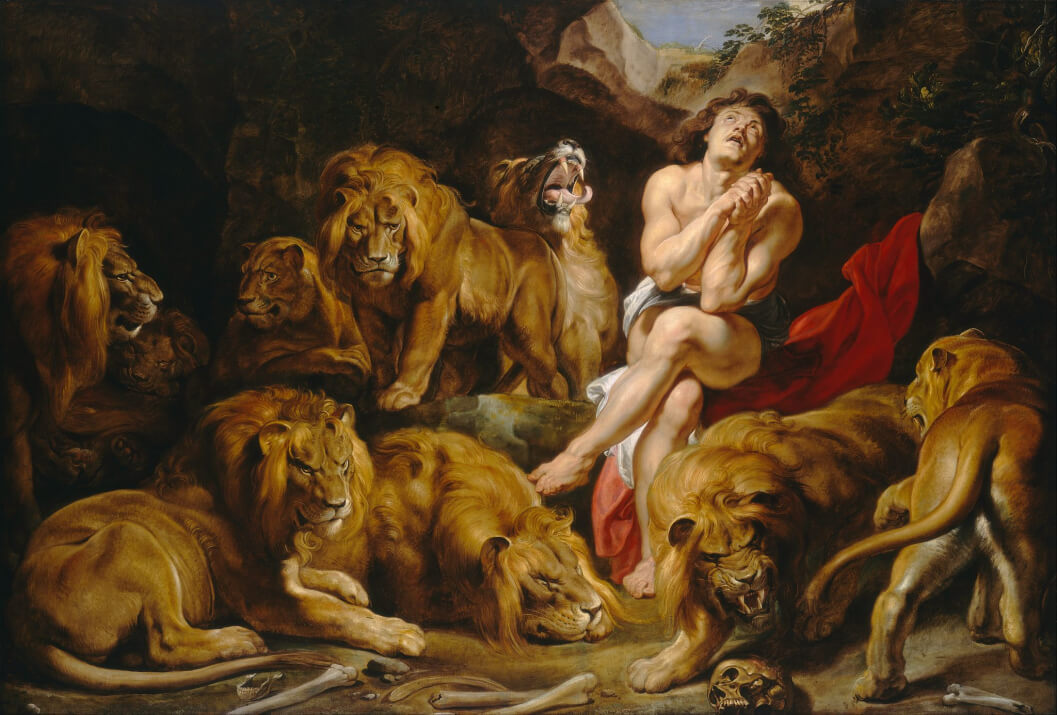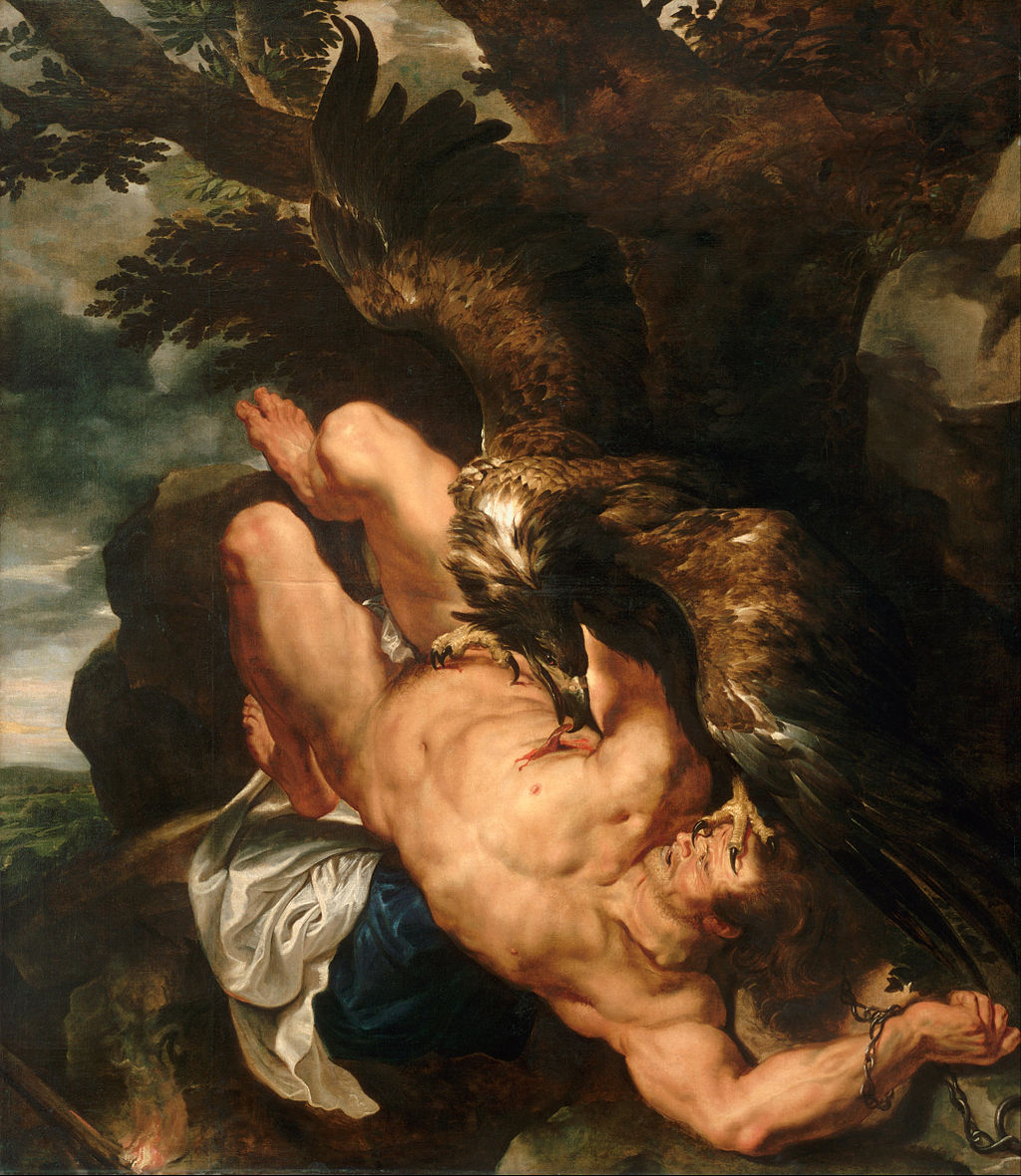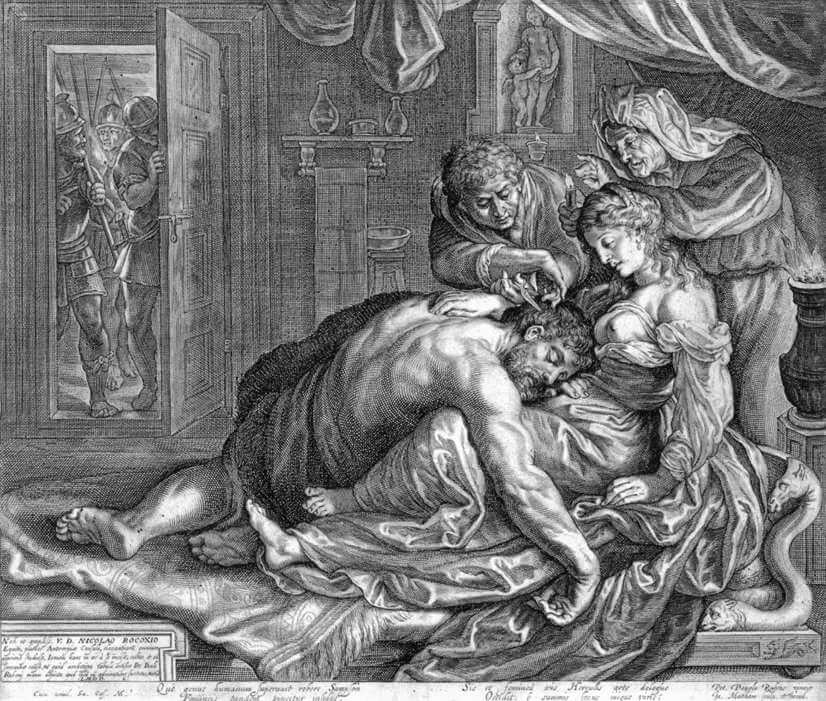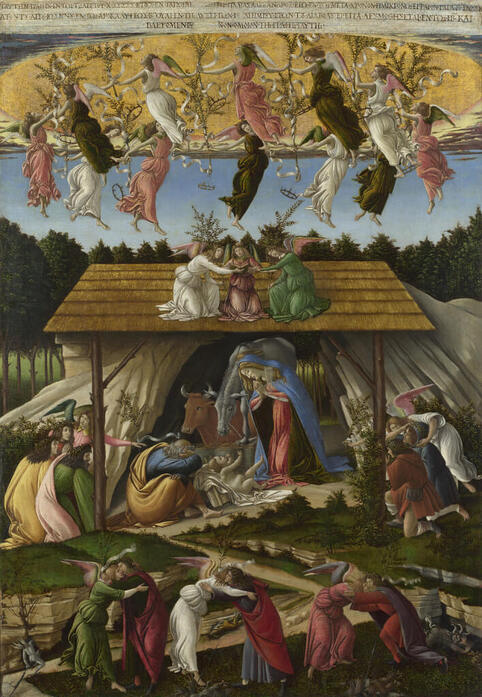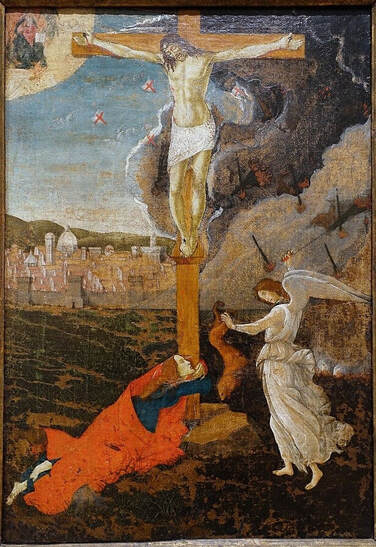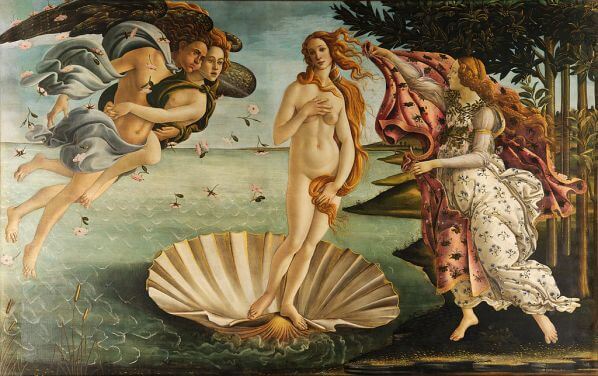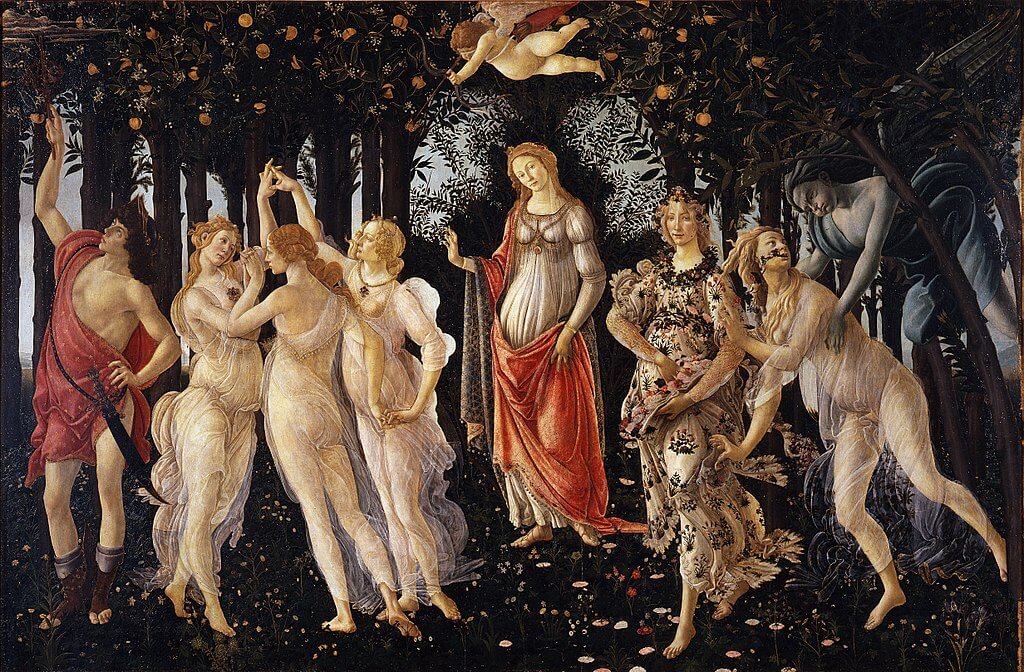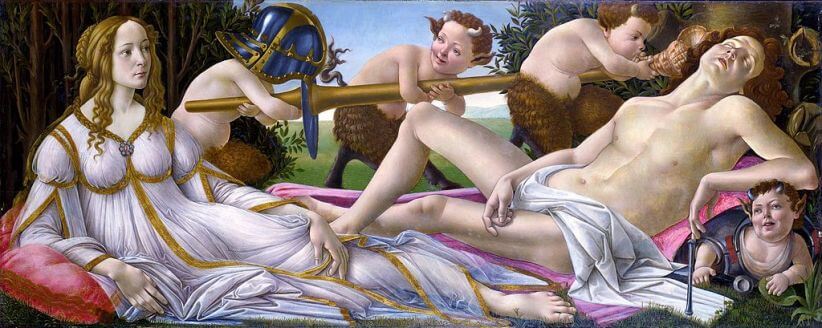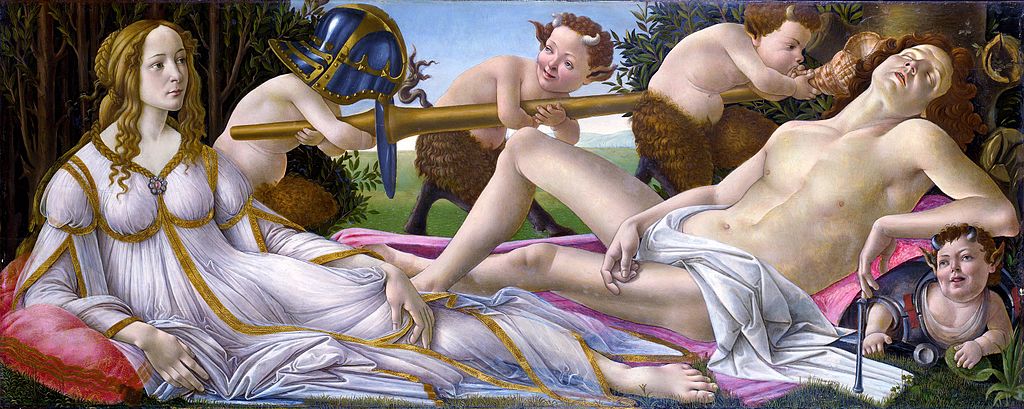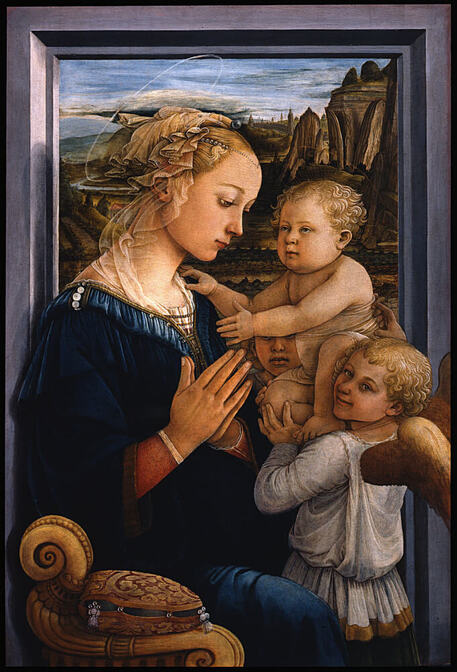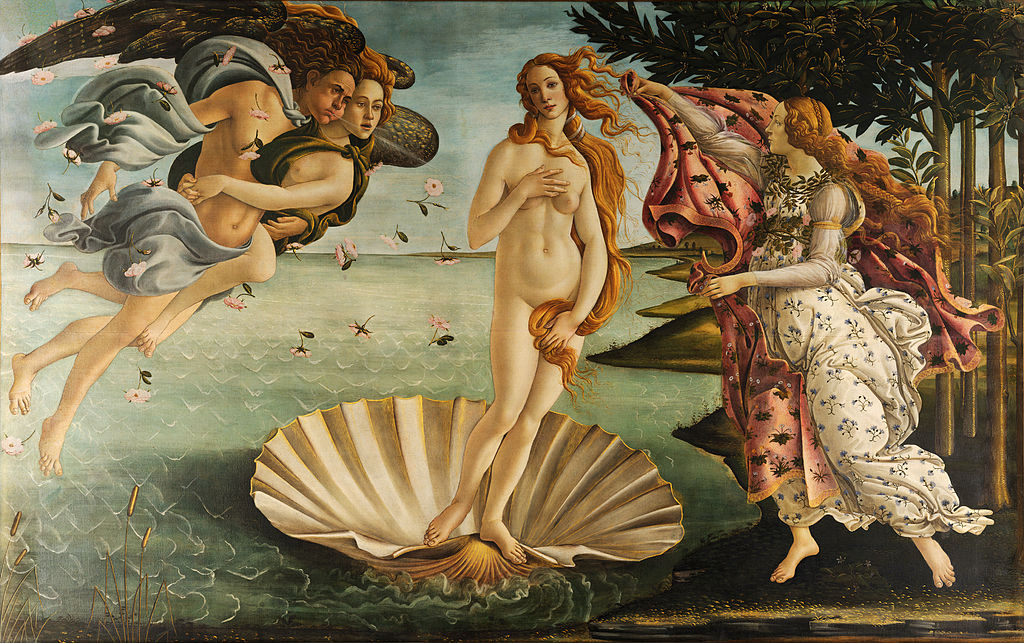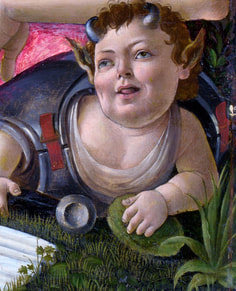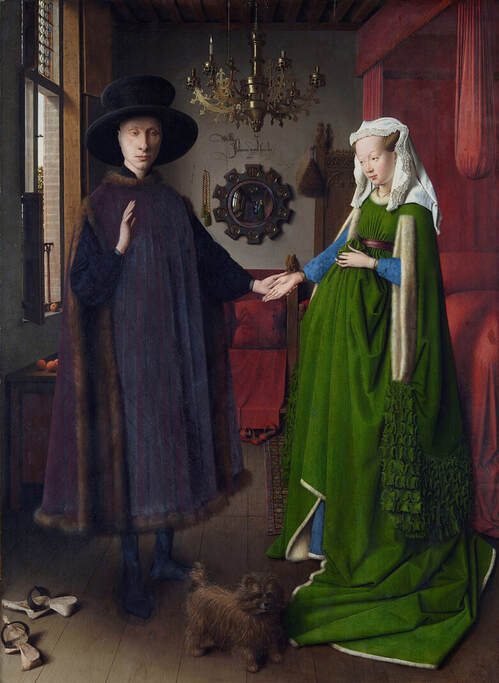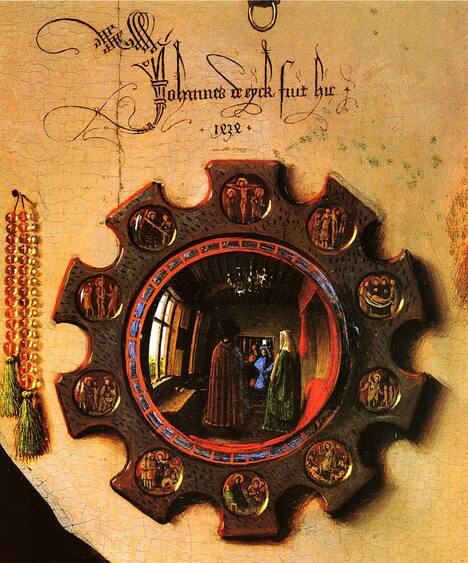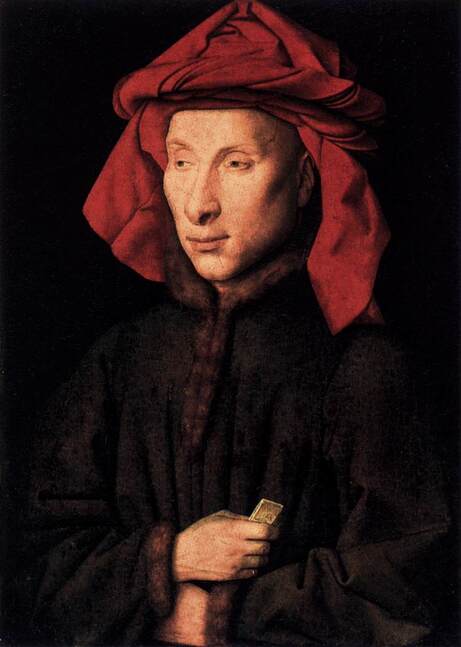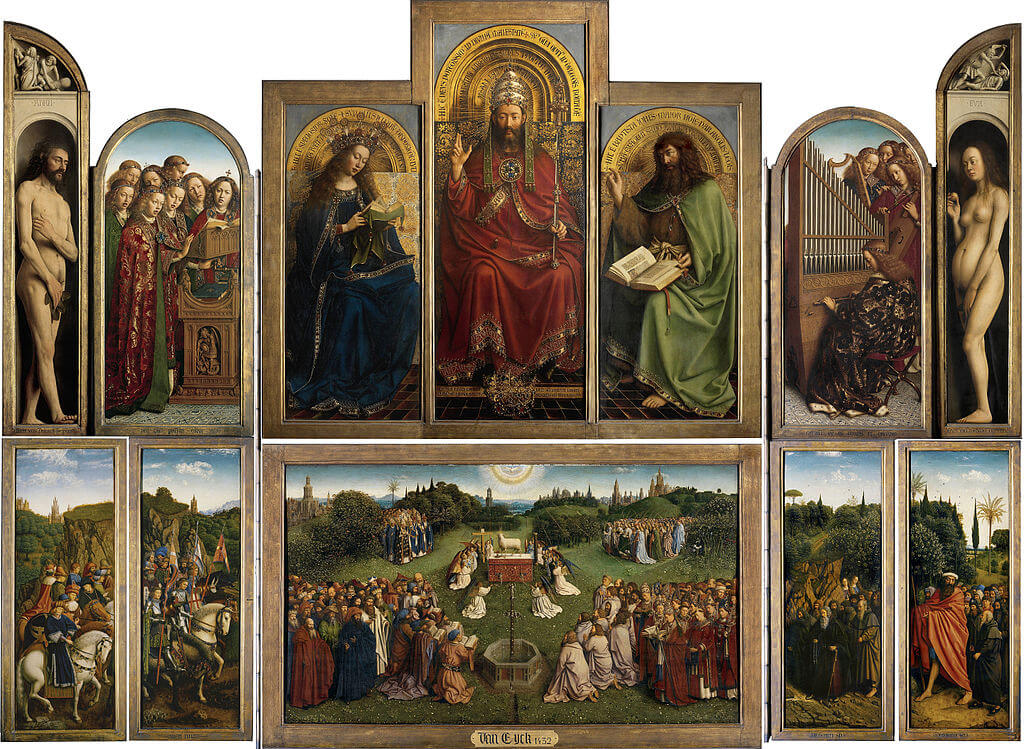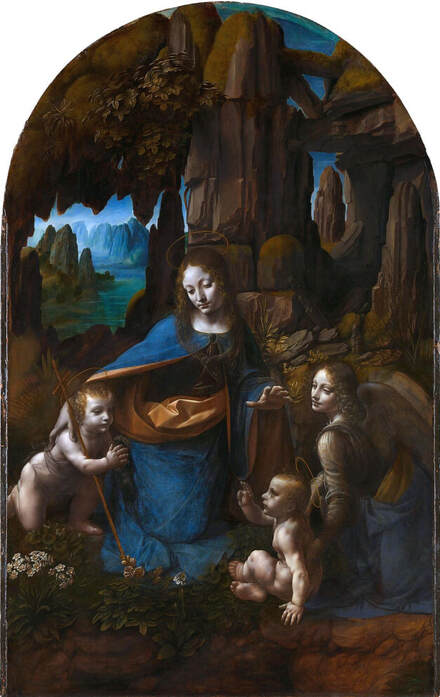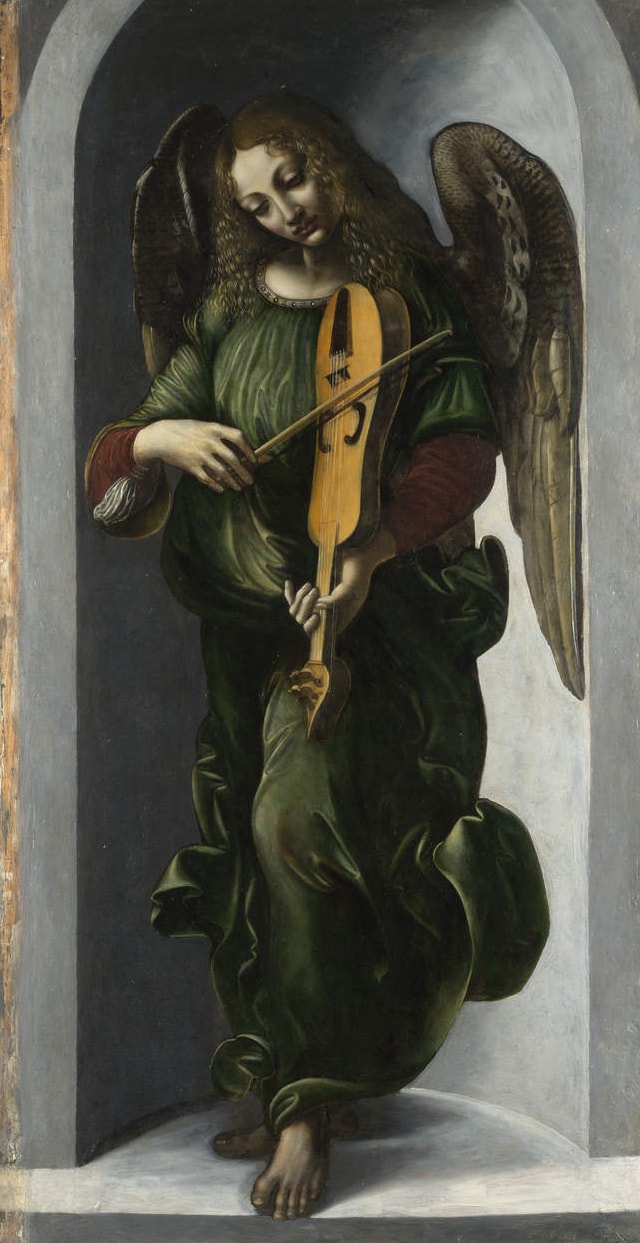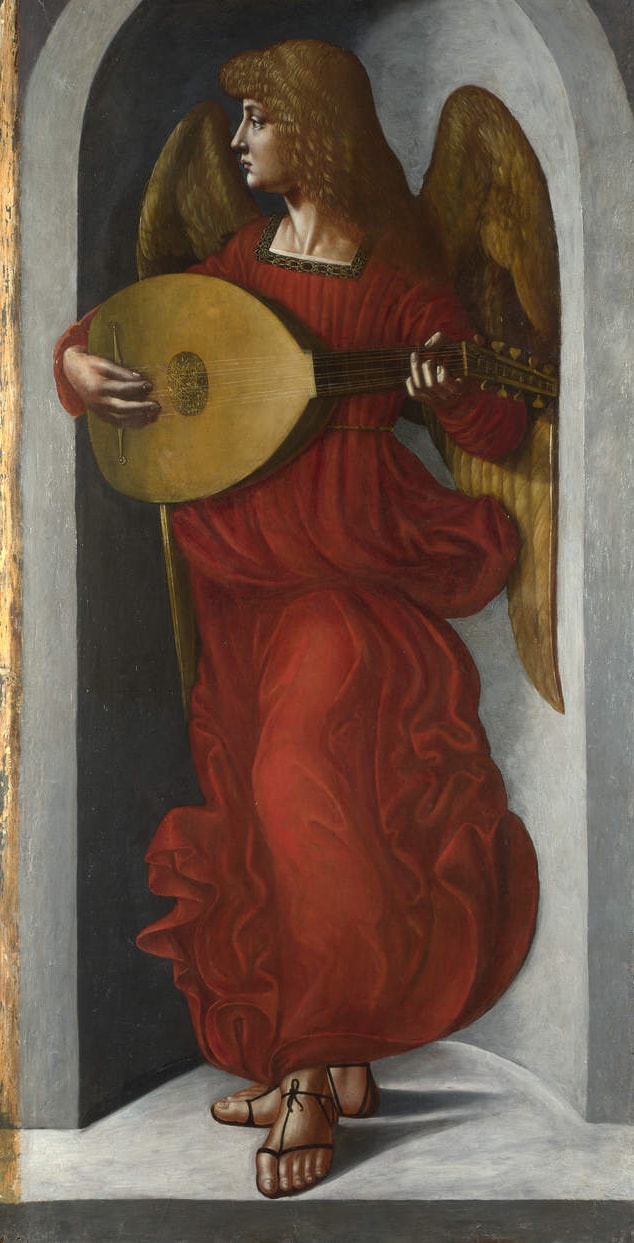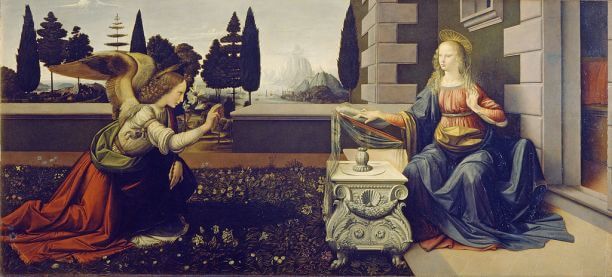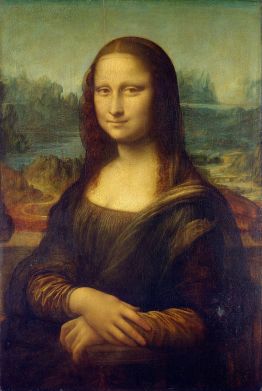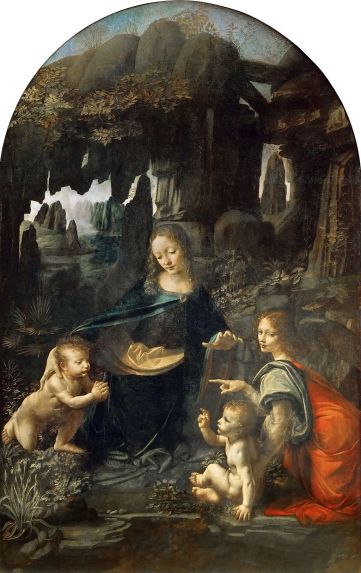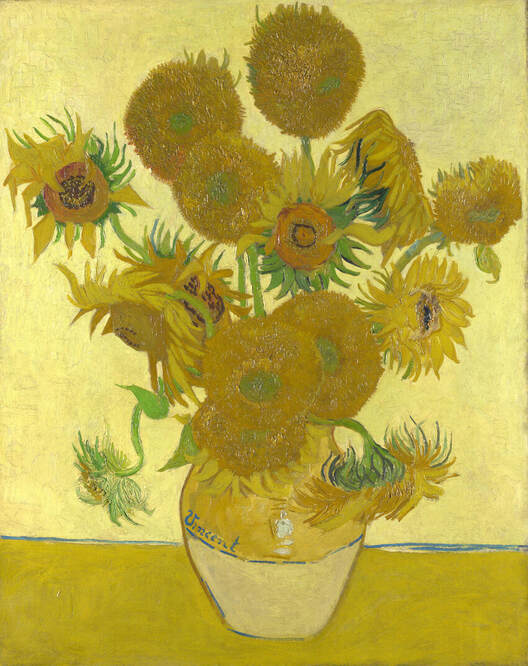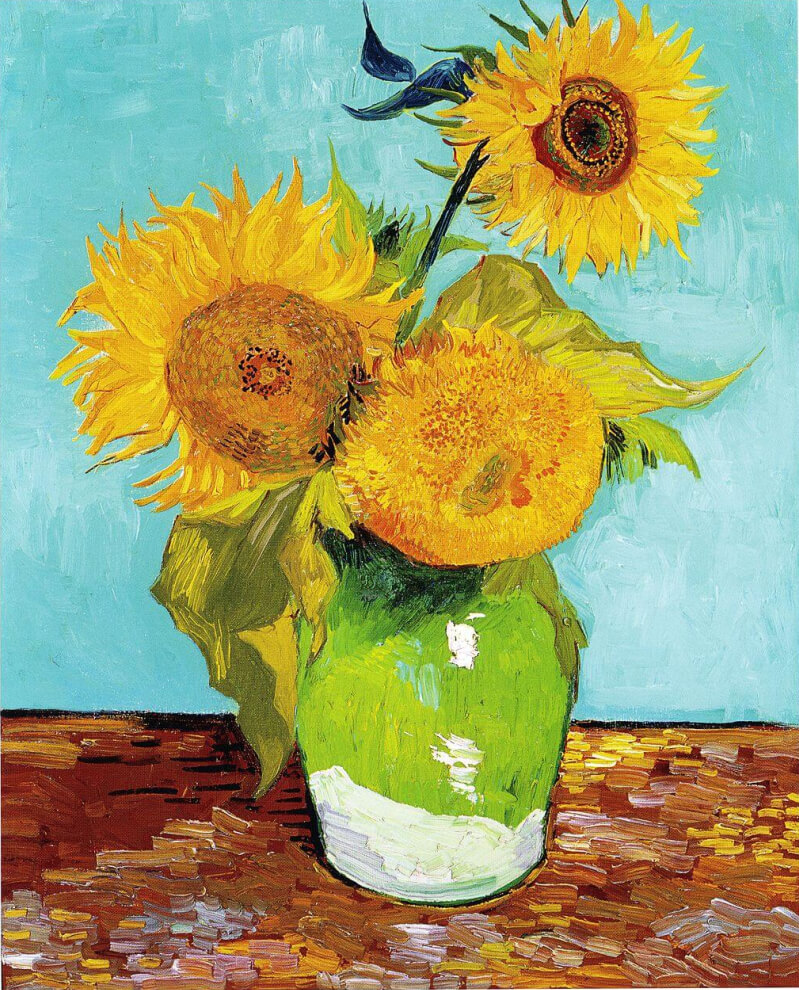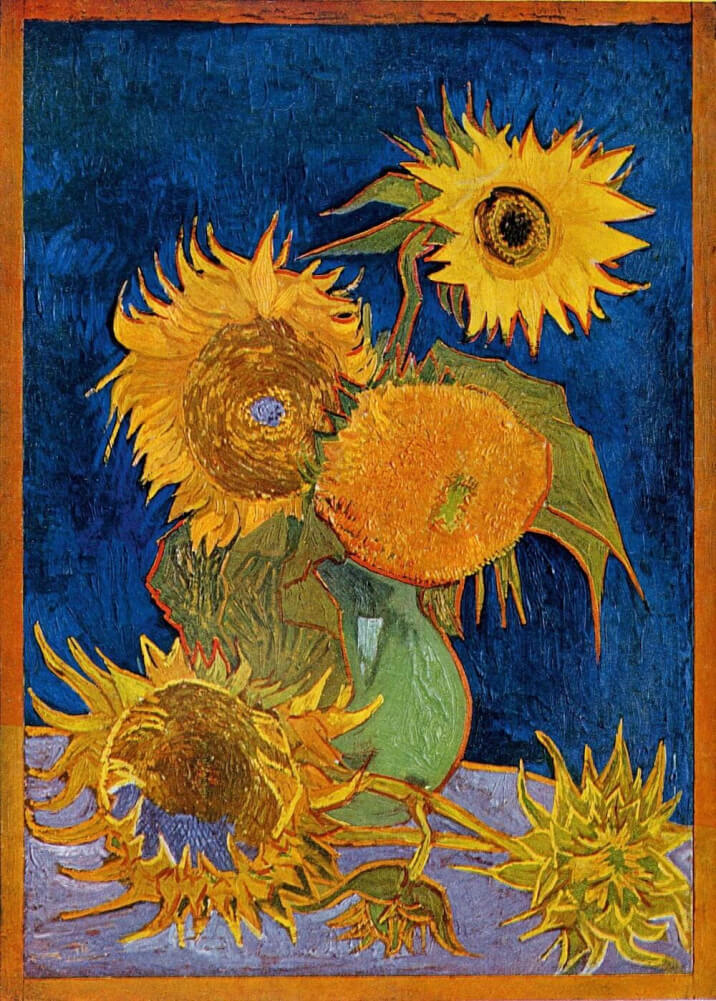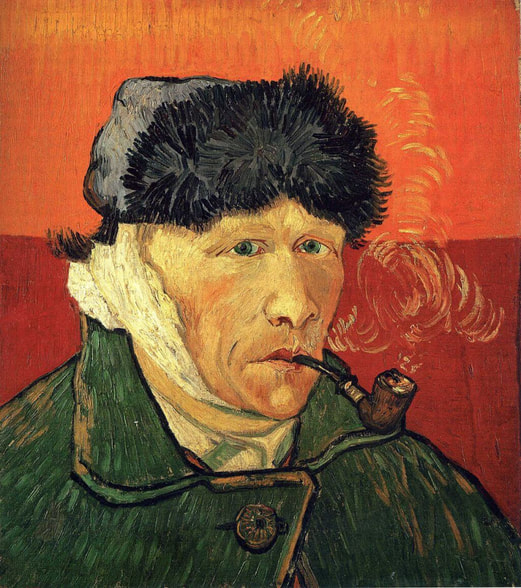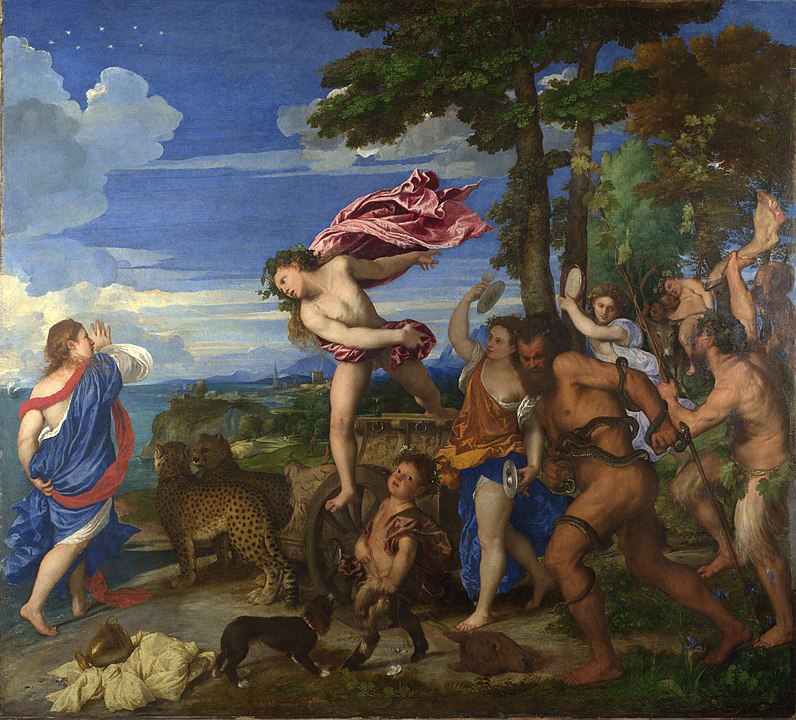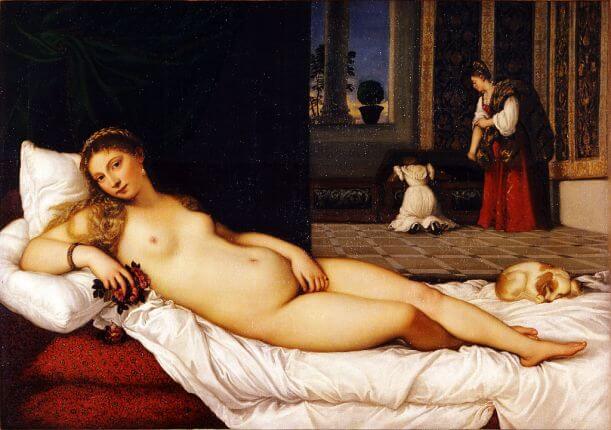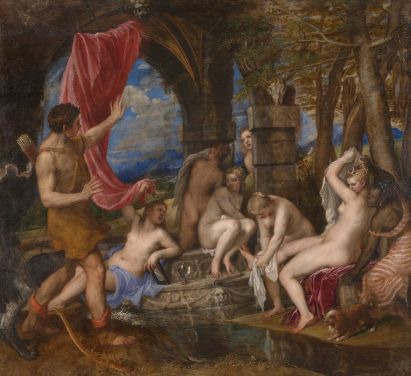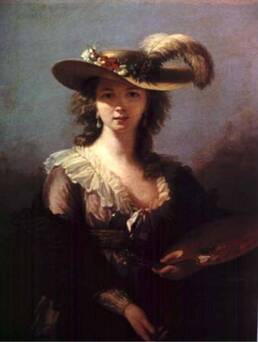 Original version of Self Portrait in a Straw Hat (1782) Original version of Self Portrait in a Straw Hat (1782)
Where? Room 33 of the National Gallery in London
When? 1782 Medium and size: Oil on canvas, 97.8 × 70.5 cm. What do you see? A self-portrait of the 27-year old Élisabeth Vigée Le Brun. She painted herself standing outside, wearing a straw hat with an ostrich feather and a garland of wildflowers. And she holds a palette and seven brushes in her left hand. She portrayed herself as an independent and emancipated woman, traits that helped her to become a successful artist in a male-dominated art world. Many other young ladies would have worn a corset, a wig, and a lot of make-up. Instead, Vigée Le Brun portrays herself in a fashionable, pink cotton dress, a black shawl, a straw hat, a pair of earrings, and her own hair. Vigée Le Brun paid particularly careful attention to the impact of two light sources, the sunlight and the daylight. The impact of the sunlight is apparent when looking at how she painted her eyes in the shadow of the straw hat. The result is that the viewer is naturally directed to look at her neck and chest. Backstory: The painting in the National Gallery is actually a copy of a version she made earlier in 1782 and exhibited at the Paris Salon. The original painting is in a Swiss private collection and only a low-resolution image of it is available. The self-portrait of Élisabeth Vigée Le Brun was inspired by the Portrait of Susanna Lunden (c. 1622-1625) by Peter Paul Rubens, which is also part of the collection of the National Gallery. In 1782, during her travels with her husband, she came across Rubens’ portrait in Antwerp. She was particularly impressed by the way Rubens simultaneously incorporated the effects of both natural daylight and sunlight. She immediately started to apply these ideas to her own portrait. After she returned to Paris, she created a second version of this painting, which is the one in the National Gallery today. The same year she also painted the Portrait of Yolande-Martine-Gabrielle de Polastron, Duchess of Polignac, which has a quite similar composition.
0 Comments
Where? Room 27 of the National Gallery in London
When? c. 1513 Medium and size: Oil on panel, 62.4 × 45.5 cm. What do you see? It shows a portrait of a grotesque woman in luxurious clothes. Her face is somewhat malformed due to her suffering from Paget’s Disease. Massys did not try to idealize her, which is also evident by the wart on her cheek. The woman, however, is dressed in luxurious clothes, including a beautiful brooch on top of her headgear and several rings on her hands. Her outfit would have been fashionable some decades earlier, but by the time this was painted, it would be out of fashion. The painting is a pendant to the portrait of An Old Man, which Massys painted in the same year. The woman is depicted as a temptress, which Massys expressed via various clues. First, she holds a rosebud in her right hand, a flower with sexual connotations. Second, she shows a fair amount of cleavage, which would be considered quite scandalous. Third, her headgear decorated with roses, also known as a escoffion, is in the form of a heart shape, although it may simultaneously be interpreted as a pair of horns.
Where? Room 9 of the National Gallery
When? 1565-1570 Commissioned by? The Pisano family, probably Francesco Pisani What do you see? This painting is full of activity. The main attention goes to the two groups of life-size people in the foreground. The painting shows how the family of Persian King Darius (in the center) appears in front of King Alexander the Great and his following (on the right) to ask for mercy. The man on the right, dressed in red and gold, is Alexander the Great. To his right, with the orange cape, is his good friend and advisor Hephaistion who is pointing to himself. Alexander is further surrounded by other high-ranked officers in his army, some of which a carrying a weapon called a halberd. The woman in blue in the center foreground is the mother of Darius, Sisygambis. She is pleading for mercy on behalf of her family. To her left, dressed in gold is the wife of Darius, Stateira, and to her left are their two daughters in beautiful identical dresses. To the right of Sisygambis is a small figure. Some say that this may be a son of Darius and Stateira, but most consider this to be a random dwarf. Alexander uses his right hand to silence Sisygambis and his left hand to point at Hephaistion as Sisygambis initially incorrectly spoke to Hephaistion instead of Alexander. The meeting between both groups takes place in an open hall within a big palace. Veronese paints the various figures in this painting in colorful and expensive contemporary Venetian outfits. The other figures in this painting are not important for the story but are basically onlookers just like us (though most of them do not seem to be interested in the main scene).
Backstory: The painting is based on the third book of the "History of Alexander the Great" by Quintus Curtius Rufus (see the full text of this book here) and the third book of the “Nine Books of Memorable Deeds and Sayings” by Valerius Maximum.
In 333 B.C., the Greek and the Persians were at war. Darius III was the King of Persia and Alexander the Great was a Greek king and army general. Alexander was aggressively expanding his territories around this time. The Greek just won the Battle of Issus (which is depicted by Pieter Bruegel the Elder). Darius fled the battle, but the Greeks captured his family. In this painting you can see the family of Darius asking for mercy to Alexander the Great. Typically, mercy was not granted and the family would be enslaved, raped, or killed. In this case, Alexander granted them mercy. Alexander actually married the oldest daughter in this painting, Stateira II, later on. The youngest daughter married later to Hephaistion.
Alexander the Great: This painting shows an important moment in Alexander the Great’s life. Hephaistion is of the same age as Alexander (around 22 years in this painting) and actually taller than him. Because of this, the mother of Darius makes a big mistake by actually addressing the advisor of Alexander instead of himself. You can see that her mouth is open and her fingers are spread as she realizes her mistake. Alexander, however, steps forward and by his hand gestures, you can see that he forgives the mistake and explains that Hephaistion is his advisor.
According to Valerius Maximus, Alexander says: “There is nothing amiss in your having taken him for me, for he too is Alexander.” This gesture shows that, besides Alexander being a great general, he is also a diplomatic leader. At the time that this painting was created, the Venetians were at war with the Turks. So, the Pisano family commissioned this painting to teach the values of Alexander the Great to the visitors to their villa. Who is Veronese? Paolo Veronese (1528-1588) was born in Verona, Italy. He is especially known for his very large historical paintings. He learned a lot from Titian and Tintoretto, who were contemporaries and were a bit older than him. He used a lot of bright colors in his paintings, something that is typical for the painters from the Venetian School. The reason for this was that the pigments arrived in Italy through the port of Venice and thus the most beautiful colors were widely available there for the best painters. In his work, Veronese was interested in using historical stories to provide some useful life lessons to the people in Venice. Veronese also liked to include some funny details in his paintings which were not part of the narrative. Often these were a variety of animals. See, for example, also all the animals in his masterpiece The Wedding at Cana, which is in the Louvre. While this was fine to do in paintings with a nonreligious context, he actually would get in trouble when he also did that in paintings with a religious subject.
Fun fact: Veronese included some funny details in this painting. Noticeable is the chained monkey to the left of the family of Darius. Look also at the young boy holding Alexander’s robe who is looking at us. On the bottom right, you can see a boy bending over a shield as he is trying to see what is going on.
On the top right is a gigantic horse, which is the horse of Alexander and is much bigger than the other horses on the left of the painting. You can even look through some of the horses on the left as the paint has become more transparent over time. On the bottom right, you can see a big dog being held back by one of the soldiers, while on the left, you see some small and friendly dogs being held.
Where? Room 18 of the National Gallery
When? 1609-1610 Commissioned by? Nicolaas II Rockox, a kind of mayor of Antwerp What do you see? Samson and Delilah are lying in a bed. The very muscular Samson is almost naked and sleeping on the lap of Delilah. He is only wearing an animal skin (possibly of a lion that he killed with his bare hands) around his middle. Delilah is wearing a white dress with a red satin cloak and has her breasts exposed. Her face shows a gentle expression and her left hand is placed on the shoulder of Samson. The man behind Samson cuts his hair which was the source of Samson’s extraordinary strength. On the left side, an old woman is holding up a candle to provide enough light to cut Samson’s hair. On the bottom right, below Samson and Delilah, is an expensive woven carpet. On the top right, the Philistine soldiers are waiting outside the door with their weapons to capture Samson after his hair is cut. In the background of the room are various decorations. Notably, on the top left is a statue of Venus and Cupid. A large purple curtain surrounds the statue. Backstory: This painting was acquired by the National Gallery in 1980 for about $6 million. At that time, it was the second-most expensive painting in the world. This painting hung originally above a very large fireplace in the house of Nicolaas II Rockox. The bottom of the painting was about three foot/meter above the floor. Rubens created the painting such that it is best appreciated when viewed from below, though it is difficult in the current museums to hang a painting that high above the floor. A preliminary study for this painting is in the Cincinnati Museum of Art.
The Biblical story of Samson and Delilah: The story of Samson is described in Judges 13-16. He was a judge of the Israelites and received an immense strength from God to fight his enemies. The only condition to not lose his strength was that he could not cut his hair. He used his strength multiple times against the Philistines, the enemy of the Israelites.
However, as described in Judges 16, one day he falls in love with the Philistine girl Delilah. The Philistines bribe Delilah to help them to capture Samson. Delilah asks Samson multiple times what the secret of his strength is such that the Philistines can get rid of it. After telling a couple of lies first, he finally tells her that the secret is that he cannot cut his hair and that he never did (interestingly, his hair is rather short in this painting). Delilah makes Samson fall asleep in her lap and a servant cuts his hair. When the Philistines come to capture him, God has left Samson and he has lost his strength. He gets captured by the Philistines and is put in prison. After that Samson got his strength back one more time from God and killed himself and more Philistines than he had done his entire life. Symbolism: The moral of this painting is that love can cause problems. Some people even suggest that this painting portrays a brothel and if that is the case, the message of Rubens is that you should not visit those. The crossed hands of the man cutting the hair of Samson symbolize betrayal. The statue of Venus and Cupid in the background shows that the mouth of Cupid is covered by a cloth such that he cannot speak. This is an uncommon way to depict Cupid and symbolizes the belief of Samson that love (represented by Cupid) can lead to bad outcomes. Who is Rubens? Peter Paul Rubens (1577-1640) is one of the most famous Baroque painters. Between 1600 and 1608, he spent a considerable amount of time in Italy and visited, among other cities, Venice, Florence, and Rome. He was able to see a lot of art masterpieces there and was particularly inspired by the works of Caravaggio, Leonardo da Vinci, Michelangelo, and Raphael. In 1608, he moved back to Antwerp where he started his extensive studio. Rubens developed a unique painting style with an emphasis on color, movement, sensuality, and light. He created a large number of paintings, including religious ones such as the current painting and Daniel in the Lions’ Den in the National Gallery of Art, and mythological paintings such as Prometheus Bound in the Philadelphia Museum of Art.
Fun fact: There has been quite some debate over time about whether Rubens actually created this painting. While there is no doubt that Rubens created a painting of Samson and Delilah, the question is whether the version in the National Gallery is the one that Rubens painted or whether the real Rubens has been lost.
An important argument that this may not be a Rubens is related to a copy of the real Rubens painting in 1613 by Jacob Matham. There are several differences between the copperplate engraving of Matham and the painting of Rubens, such as the right foot of Rubens which is not entirely in the painting, the position of the old woman, the statue of Venus and Cupid in the background, and the carpet. The main argument that this painting is not by Rubens is that the copy by Matham is more in line with the other paintings of Rubens than the painting in the National Gallery. However, nowadays most people believe that Rubens did make the painting in the National Gallery.
Where? Room 57 of the National Gallery
When? 1500 Commissioned by? Botticelli probably made this picture for himself What do you see? In the center of this painting, you can see a naked baby Jesus. His mother, the Virgin Mary, is depicted to his right and is much larger than the other figures. His father, Saint Joseph, is on his left. Behind Jesus are a horse and an ox. Together they are staying in a stable. On top of the stable are three angels. One is reading a book, and the other two are holding an olive branch. To the left of Joseph is an angel in pink, holding an olive branch with a scroll attached to it, while reaching out to Joseph to introduce the three wise men. On the right of Mary is another angel with three shepherds who want to pay their respects to Jesus. In the foreground are three pairs consisting of one angel and one man embracing each other. Each pair holds an olive branch in their hand with a scroll attached to it. They are surrounded by several little imps or devils who are killing themselves with their spears. On top of the painting is a choir of 12 angels holding hands. The angels are doing a mystic ring dance. They are also holding an olive branch in their hands with a scroll attached to it and a crown hanging at the bottom of the branch. The angels are under the golden dome of heaven. Above this dome is a Greek inscription based on some parts of the Revelations of John related to the apocalypse. Backstory: This painting is also called ‘The Mystical Nativity’, and it is the only painting that Botticelli signed. This painting combines the story of the birth of Jesus with his return to earth according to the apocalypse. The title of this painting contains the word mystic because the parts of the painting referring to the apocalypse are prophetic and express a mystery. The word mystic is occasionally used to refer to exceptional paintings with mysterious and symbolic content. Another example of such a painting is the Mystic Crucifixion by Botticelli which is in the Fogg Art Museum in Boston.
Inscription: The inscription on top of the painting contains a message in Greek. It is translated as: “I Sandro painted this picture at the end of the year 1500 in the troubles in Italy in the half time after the time according to the 11th chapter of St. John in the second woe of the Apocalypse in the loosing of the devil for three and a half years. Then he will be chained in the 12th chapter and we shall see him trodden down as in this picture.” This message of Botticelli is based on the 11th and 12th chapter of the Revelations of John.
Botticelli believed that the apocalypse as described in the Bible was going to happen in 1504. Specifically, he believed that he was living in the Tribulation, a short period of time in which the world would suffer from hardship and disasters. He believed that the Millennium, a period of a thousand years during which Jesus would return to earth, would start in three and a half years. This belief of Botticelli was particularly based on the various wars going on at that time and the hanging, two years earlier, of the Florentine preacher Savonarola of whom Botticelli was a follower. Symbolism:
Who is Botticelli? Sandro Botticelli (1445-1510) was born as Alessandro di Mariano di Vanni Filipepi in Florence. Most of his paintings have a religious theme, but he also painted portraits and mythological scenes. The latter theme resulted in his most famous works, such as The Birth of Venus and La Primavera, both in the Uffizi Museum. His painting of Venus and Mars, which is also in the National Gallery, is also a masterpiece. In the 1490s, Botticelli got heavily influenced by the extremist preacher Savonarola, and he even stopped painting for a while to become a full member of Savonarola’s sect. However, he picked up painting again after a while, though his productivity was lower than before (though this is not entirely certain as almost all paintings of Botticelli are undated).
Fun fact: The Nativity scene in this painting is the story of the birth of Jesus as described in the gospels of Matthew and Luke. Mary was still a virgin, and God promised her that she would give birth to the Christ. The accounts of Matthew and Luke, however, differ quite a bit and both have their unique components.
According to Matthew, Jesus was visited by three wise men who followed a star to worship him. Luke describes that an angel announces the birth of Jesus to the shepherds and that they subsequently visit Jesus. Also, according to Luke, but not according to Matthew, the birth of Jesus happened in Bethlehem and Jesus was born in a stable. Botticelli combined elements from both gospels for this painting. Interested in a copy for yourself? Poster of canvas.
Where? Room 58 of the National Gallery
When? 1482-1485 What do you see? On the left, you see the goddess Venus who is carefully watching the god Mars on the right, who is asleep. Venus and Mars are having an adulterous affair. Uncharacteristically, Mars is unarmed, and he lies on a red cloak. You can also see four fauns (mythological figures who are half human and half goat, have small horns and tails, and they are followers of Bacchus). The fauns are blowing a Triton’s shell (a hunting horn in ancient times) like a trumpet in the ear of Mars to show that after making love even this very loud sound will not wake him up. They are also jokingly playing with the weapon of Mars (a lance), his body armor (to be precise, a cuirass; see the faun on the bottom right) and his helmet (the faun on the left). Venus is wearing a beautiful dress. On the top right you can see a swarm of wasps. Also, if you look carefully, you can see the city of Florence in the distance. Backstory: This painting is both inspired by Greek mythology and a description of the Greek writer Lucian of Samosata (125-180) of a lost painting on Alexander the Great and his wife, Roxana. According to the mythological stories, Venus is still married to the blacksmith Vulcan (the god of fire) when she is having an affair with Mars. Whenever Venus was having an affair, Vulcan would get so angry that he treated the metal with such force that it created a volcanic eruption. Based on the dimensions of the painting (27 x 69 inches – 69 x 174cm), this painting was likely meant to be a decoration for the backboard of a bed or a storage box. The National Gallery acquired the painting around 1874 for £1,050. Symbolism: The overall message of this painting is that love trumps war. Venus (the goddess of love) is awake, while her lover Mars (the god of war) is asleep. On the top right, you can see a swarm of wasps, which represent the stings of love. They may also refer to the Vespucci family (vespa is Italian for wasp). Simonetta Vespucci was a beautiful woman who most likely served as the model for this painting, and she was the inspiration for many of Botticelli’s paintings. The myrtle trees behind Venus are one of the main symbols of Venus as myrtles are known as a potent aphrodisiac. Who is Botticelli? Sandro Botticelli (1445-1510) was a painter who belonged to the Florentine school of painters. Botticelli was initially trained by his brother to become a goldsmith, but at the age of 14, he became an apprentice to the successful painter Filippo Lippi (1406-1469), known from the painting Madonna and Child with Two Angels. Greek mythological stories often inspired Botticelli’s work, and he used Venus more often as a topic for his work. For example, Venus was also the center of attention in his famous paintings The Birth of Venus and La Primavera, both in the Uffizi Museum. Botticelli was in love with Simonetta Vespucci (a cousin-in-law of the explorer Amerigo Vespucci), who was already married to someone else. Simonetta was known as the greatest beauty of her time and died in 1476. As a result, Botticelli never married. Throughout his life, he has been inspired by Simonetta, who has served, according to popular belief, as the inspiration for many of his paintings (including the current one). According to his wish, Botticelli was buried at the feet of Simonetta Vespucci.
Who are Venus and Mars? Venus is the Roman goddess of love, beauty, sex, fertility, prosperity, and desire. Venus is also known in the Greek mythology as Aphrodite. In Latin the noun Venus means ‘sexual desire’. Julius Caesar claimed to be an ancestor of Venus.
Mars, the god of war, is one of the lovers of Venus. Mars is also an agricultural guardian. The Greek counterpart of Mars is Ares. The third month of the year, March, is named after him. In many mythological stories, Cupid is portrayed as the son of Venus and Mars.
Where? Room 56 of the National Gallery
When? 1434 Commissioned by? Possibly Giovanni di Nicolao Arnolfini, an Italian merchant living in Bruges, as a memory of his deceased wife. What do you see? On the right is a woman in a green dress. On the left is a man with a big hat who raises his hand to the woman. The couple is holding hands. It is believed that this is their wedding day and they are dressed in expensive silk and fur. A small dog is standing in front of them. At first, it looks like the bride is pregnant, but this is not the case. When you look carefully, she pulls up her dress merely to indicate her desire for children. In between the couple, you can see a small part of an expensive Oriental rug. In the mirror, we can see two other people that entered the room. The mirror is surrounded by ten small paintings of the passion of Christ. Below the mirror is the signature of Van Eyck which reads: ‘Johannes de Eyck fuit hic 1434’, which means ‘Jan van Eyck was here, 1434’. This signature may suggest that Van Eyck is one of the people we can see in the mirror. To the left of the mirror hang, so-called, prayer beads of crystal. Above the couple is a chandelier with candles. Only one of the candles above the groom is lit. The couple has both taken off their shoes. The white with black shoes of the man are in the left foreground and under the red bench is a pair of red shoes from the woman. On top of the bed is a wood carving of Saint Margaret with a dragon at her feet. To the left of this carving hangs a hand brush. On the left of the painting are four oranges and outside you can see a small part of a cherry tree.
Backstory: This painting is known by several alternative names, such as The Arnolfini Double Portrait, The Arnolfini Marriage, and The Arnolfini Wedding.
The painting probably depicts Giovanni di Nicolao Arnolfini and his wife Giovanna Cenami on their wedding day, and the painting serves as a kind of marriage certificate. Giovanni was a rich Italian merchant from an influential family in Lucca in Italy. At the time of this painting, he was living in Bruges, which was an important trading city. He probably remained there for the rest of his life. This painting not only celebrates their marriage but is also a way to show off the valuable possessions of the couple. Around 1438, Van Eyck created another portrait of Giovanni, which is now in the Gemäldegalerie in Berlin.
Symbolism: This painting is full of symbolism. The couple holding hands represents the unity of the couple through marriage. The prayer beads are a gift from the groom and represent purity in the marriage. The couple has both taken off their shoes indicating that this is a sacred place.
Standing with bare feet also represents fertility. The green dress of the woman also represents fertility. The carving of Saint Margaret symbolizes her role as the patron of childbirth. The bulge in the dress of the woman indicates her desire for children. She is standing in front of the bed, which further emphasizes this desire and shows her role in the marriage. The man is standing near an open window symbolizing his role in the outside world. The red color of the bed and the bench represent passion. The dog represents fidelity. The hand brush represents the role of the woman as a housewife. The oranges are also referred to as Adam’s apples and represent the forbidden fruit that Adam and Eve ate in the paradise. They should remind the couple not to fall prey to the sin of lust. Only a single candle above the man on the chandelier is lit. The candle above the bride is not lit anymore (you can still see the leftovers of a burnt candle) and may refer to the fact that she died already. If Giovanni di Nicola Arnolfini is indeed the commissioner of this painting, his wife died in the year before the creation of the painting. The lit candle also represents the eye of God who can see everything. Who is Van Eyck? Jan van Eyck was born between 1380 and 1390 in Belgium and died in 1441. He was well educated and active in Belgium, France, and The Netherlands. He was a court painter, but also took private commissions of which most were portraits. In addition, he served as a diplomat for the government. Jan van Eyck is considered one of the most important painters of the Northern Renaissance. He has created both religious and nonreligious works which was fairly rare during his time. He was one of the first painters to sign his paintings and one of the first to use oil paint instead of the tempera method which was common during his time. Van Eyck had a big influence on many future Flemish and Dutch painters, including Johannes Vermeer. His most famous work is the Ghent Altarpiece in the St. Bavo's Cathedral. He created this piece together with his brother Hubert van Eyck.
Fun fact: It is hard to believe that during the time of this painting, couples could marry without the presence of a priest or any witnesses. In this painting, the couple gets married in a domestic setting, and only the presence of a notary was required. This is surprising given the important role of the church in society during that time.
Only since the Council of Trent, between 1545 and 1563, it was required that a priest and two witnesses needed to be present for the marriage to be valid. The presence of witnesses is still a requirement for weddings in a large part of the world. Interested in a copy for yourself? Poster of canvas (Amazon links).
Where? Room 66 of the National Gallery
When? 1495-1508 Commissioned by? Prior Bartolomeo Scorlione and the Confraternity for the Chapel of the Confraternity of the Immaculate Conception in the church of San Francesco Maggiore in Milan. What do you see? The Virgin Mary, the children Jesus and John the Baptist, and an angel are pictured in a triangular composition in a rocky environment. The Virgin Mary is sitting on the ground, which is referred to as the Madonna of Humility. She is the center of attention in this painting. The right hand of Mary is on the shoulder of John the Baptist (who is the child on the left). The left hand of Mary is right above the head of Jesus, which can be interpreted as a protective gesture. John the Baptist is folding his hands and is praying towards Jesus. At the same time, Jesus, who is directly to the left of the angel, is raising his right hand to bless John the Baptist. The angel most likely represents the Archangel Gabriel, even though the angel looks quite feminine (the painting of androgynous figures was a trademark of Leonardo da Vinci). In the background you can see the rocky grotto and a river, most likely inspired by the Dolomite Mountains, which are to the northeast of Milan. In the foreground and the grotto, various flowers and plants are depicted (including irises, lilies, and ivy). Backstory: The commissioner of this painting wanted Leonardo da Vinci to paint the Immaculate Conception (a Catholic dogma that Mary was born without sin) to serve as the center of an altarpiece for the Chapel of the Immaculate Conception. This chapel is part of the Saint Francesco Grande church in Milan, and the chapel has been founded before 1335 by Beatrice d’Este, who was the wife of Galeazzo I, the Duke of Milan. On the left and right of this painting would be two paintings of angels playing a musical instrument to complete the altarpiece. On the left is An Angel in Green with a Vielle painted by an associate of Leonardo, possibly Francesco Napoletano. On the right is An Angel in Red with a Lute by Giovanni Ambrogio de Predis.
Leonardo da Vinci has painted the biggest part of this work but he has some help from his assistants. One important argument, according to The Guardian, which supports the involvement of some assistants is that some of the flowers and rocks are not accurately depicted (whereas one of the trademarks of Leonardo is that he was always very accurate in depicting natural elements in his work).
Symbolism: The rocks and caves represent sanctuary. The rocks also refer to Jesus, who is often called the rock of the Christian religion. The flowers and plants are also carefully chosen. For example, the palm leaves, which can be seen behind the head of John the Baptist, are a symbol of Mary and a symbol of Jesus victory over earthly temptations. The angel is clearly identified based on his wings. Mary is directly visible by her blue clothing and the halos help us to identify who is sacred/holy. John the Baptist can easily be identified by his cross of martyrdom. Who is Leonardo da Vinci? Leonardo da Vinci (1452-1519) was born in the Italian village of Anchiano, which was very close to Vinci, which is where he got his name from. He was an architect, astronomer, engineer, inventor, mathematician, musician, painter, writer, and much more. Leonardo da Vinci is known to be one of the biggest multi-talented people that the world has ever seen. Leonardo was notorious for being substantially late in delivering his paintings and was not afraid to abandon projects halfway. Most of the surviving paintings of Leonardo have become famous, including The Annunciation (in the Uffizi Museum) and the Mona Lisa (in the Louvre).
Fun fact: Interestingly, there are two versions of this famous painting. The other version of The Virgin of the Rocks is in the Louvre.
The version in the Louvre was the first to be completed and is much less conventional. For example, the current version in the National Gallery contains halos on top of the heads of John the Baptist, Jesus, and Mary, and John the Baptist is carrying a cross with him (these elements are not present in the version in the Louvre). You can also see a clear difference in the face of Jesus. Also, in the National Gallery version of the painting, the angel is not pointing at John the Baptist and seems to gaze in the distance (as if the angel is dreaming/imagining this scene, instead of participating in it). The reason that there are two versions of this painting is that the Confraternity rejected the first version of Leonardo. It was not traditional enough (for example, no halos and a lack of symbolism) and thus did not suit the purpose of representing the dogma of the Immaculate Conception (which was the sole purpose of the Confraternity). Leonardo da Vinci considered the Louvre version of the painting a real masterpiece in which he could perfectly express his artistic ideas. After the Louvre version of the painting was rejected, Leonardo created another version of this painting (the current version), which included all elements that the Confraternity asked for. Interested in a Copy for Yourself? Poster
Where? Room 43 of the National Gallery
When? 1888 What do you see? A total of 15 sunflowers is depicted. The sunflowers are actually dying, and you can see that almost half of the sunflowers does not have any petals left. Specifically, six sunflowers only have their flower head left, and the sunflower on the top right only has a single petal on it. This is an indication that they are at the end of their life. The sunflowers that we often adore are the ones with the petals still on it, and in combination with the flower head, they make the sunflower look like a sun with rays. The petals of the sunflowers that still have them are quite spiky. Notice also the colors that Van Gogh used. Besides some green, he used different shades of yellow. It is very difficult to create a painting with a clear subject and interpretation with such a limited array of colors, yet Van Gogh succeeded in creating a painting of sunflowers that can be recognized from a large distance. This still-life painting beams of the wall and energizes people around the world, something that is very uncommon for still-lifes which are often considered to be somewhat dull. Backstory: A painting of sunflowers is immediately associated with Van Gogh. He created a total of 11 paintings of sunflowers. The first series of four paintings shows sunflowers lying on the ground and the second series of seven paintings shows sunflowers in a vase. This second series contains four originals which he created in a single week. Van Gogh also made three copies of the paintings in the second series. Two of these three copies are copied from the Sunflowers version in the National Gallery. One of these copies is currently in the Van Gogh Museum in Amsterdam, and the other copy is in the Seiji Togo Memorial Sompo Japan Museum of Art in Tokyo (this version was sold for almost $40 million in 1987, making it the most expensive painting ever sold at that time). Sunflowers for Paul Gauguin: Van Gogh’s idea was to create these sunflower paintings as a decoration for the room of Paul Gauguin who would join him in Arles to paint. He knew that Gauguin liked sunflowers as, in the year before, Gauguin had exchanged one of his paintings for two of the earlier sunflower paintings of Van Gogh. Van Gogh was very excited that Gauguin would visit him and was in a fantastic mood when he created his second series of sunflower paintings. When Gauguin arrived, he was indeed impressed by these paintings and even Van Gogh himself was quite happy with the results (which was uncommon for him). The interest of Van Gogh in flowers was probably stimulated by his nationality as flowers are a very big part of the culture in The Netherlands. In fact, The Netherlands is the biggest flower exporting country in the world.
Symbolism: These sunflowers also have a symbolic value (though it is not clear how important this symbolic value was to Van Gogh). Flowers are a symbol of life. They have a period in which they bloom beautifully and they are in their prime, but eventually, they die. The cycle of a flower’s life is often used as an analogy for human life and should remind us of our own mortality. However, inside the flower head are the seeds of new life. These seeds refer to the cycle of life on this planet.
Who is Van Gogh? Vincent van Gogh (1853-1890) was born in Zundert in The Netherlands. He only started his artistic career in 1881 and so all the works we know from him are made within one decade. For many of his later paintings, Van Gogh studied a landscape, the sky, or some flowers in front of him while working on the painting. He liked to be outside while painting. His favorite color, which you can see in many of his paintings, is yellow. He considered yellow to be the color of life (as the sun is also yellow). Van Gogh developed a unique style of painting, which is very recognizable. Especially in his later years, he applied thick layers of paint to the canvas and used heavy brushstrokes. His work appeals worldwide to many people that are otherwise not so interested in art. Fun fact: Van Gogh’s idea was to create a painting community in Arles, where he moved in February 1888, but nobody wanted to join him there initially because of his difficult personality. However, the brother of Vincent convinced Paul Gauguin to join him and Vincent was very excited about this. On October 23, 1888, Gauguin joined Van Gogh in Arles. But the collaboration did not turn out well and Gauguin left in December 1888. According to Gauguin, Van Gogh threatened him with a razor and Gauguin ran away. That same night Van Gogh mutilated his own ear with a razor blade, which caused severe bleeding. He applied a bandage to his ear and packaged his ear in a piece of paper, which he brought to a woman in the brothel nearby that he frequented. He painted a self-portrait with a bandaged ear and pipe which is currently in a private collection.
Written by Eelco Kappe
Where? Room 2 of the National Gallery
When? 1522-1523 Commissioned by? Alfonso d’Este, the Duke of Ferrara, to decorate one of the rooms in his Ducal Palace. What do you see? On the left is Ariadne in a blue dress. She is left behind by Theseus on an island. You can still see the ship of Theseus near the horizon in the middle left of the painting. An almost naked Bacchus is jumping out of his chariot, which is carried by two cheetahs. Bacchus is immediately in love with Ariadne, but Ariadne seems hesitant as she is still dealing with the fact that Theseus left. While her arms and body are still in the direction of the ship of Theseus, her head is turned to Bacchus. Bacchus convinces Ariadne to marry him. Bacchus promises Ariadne to turn the diadem that Ariadne was wearing during their wedding into a constellation of stars, which you can see in the top left of the painting. Bacchus has also brought his entourage of drunk and crazy people on the right. One of his followers is holding the leg with a hoof of a cow that he just ripped off. You can see the head of the cow in the foreground, which is dragged along by a young boy. Completely on the right is a man carrying a barrel of wine and in the foreground, a man is trying to break free from snakes. Backstory: Alfonse d’Este originally commissioned Raphael and Fra Bartolommeu to make this painting but both died before they could start their work. He then decided to give the work to Titian. This painting is based on the mythological stories of the Latin poets Catullus and Ovid. The story is about Princess Ariadne from the Greek island of Crete. She fell in love with Theseus from Athens and helped him to kill the Minotaur. They left together from Crete, but Theseus abandoned her while she was asleep on the Greek island of Naxos. Ariadne was heartbroken when she discovered that Theseus had left and ran along the beach of Naxos to see if she could see any signs of him. At that moment, Bacchus - the god the wine, fertility, madness, theatre, and religious ecstasy - arrived. Bacchus had fallen in love with Ariadne and asked her to marry him. The painting is famous because Titian is able to paint a moment that is frozen in time in a very energetic scene. Notice also the beautiful use of bright color, typical for the School of Venice, which makes this painting come alive.
Symbolism: Bacchus is wearing a crown of ivy leafs, which is the sacred plant to Bacchus to prevent intoxication (which is what people in the past believed that ivy could do). The constellation of stars (which we now refer to as Corona Borealis) on the top left is in the form of the diadem that Ariadne was wearing when she married to Bacchus. It is a symbol of their marriage.
The wine barrel, tambourines, and snakes are all symbols of the lifestyle that Bacchus represents. The cheetahs refer to the collection of wild animals of the commissioner of this painting. Who is Ariadne? According to Greek mythology, Ariadne was the daughter of Minos, who was the King of Crete. Minos had built a labyrinth, with in the center a Minotaur (a creature with the head of a bull and the body of a human). He put his daughter Ariadne in charge of the labyrinth. Following an earlier dispute with Athens, every seven to nine years, 14 noble citizens from Athens were sacrificed to the Minotaur. One year, Theseus, was among these 14 noble citizens. Theseus became a hero as he killed the Minotaur, but to do that, he received help from Ariadne who was in love with him. Ariadne married in the end to Bacchus and gave him about 12 children. After Ariadne died, Bacchus brought her back from the underworld Hades and she became a Greek goddess. Why Bacchus? Bacchus was a chronic alcoholic, which made him a great subject for mythological stories and also for artworks. Bacchus was also the inspiration for popular festivals, called Bacchanalia, which were introduced to Rome in the second century before Christ. These festivals contained a lot of alcohol and nudity and were a popular theme in Renaissance art. Who is Titian? Titian (c. 1489 – 1576) was a painter and greatest member of the Venetian school of painters. He was very talented in painting both portraits and landscapes, which is and was a rare combination. In his teenage years, the Bellini brothers (Gentile and Giovanni) taught him how to paint, but his work was quickly considered to be better than that of the Bellini brothers. Some well-known paintings by Titian are his Venus of Urbino in the Uffizi Museum and Diana and Actaeon which is also in the National Gallery in London.
Fun fact: In the original story on Ariadne and Bacchus, the chariot of Bacchus was drawn by tigers. Instead, Titian painted two cheetahs. This was most likely the case, because Duke Alfonso d’Este did not have tigers, but did have cheetahs, in his menagerie.
Collecting wild and exotic animals, called a menagerie, was an impressive way to show off to your guests. Menageries of that time included animals like panthers, leopards, and elephants. Interested in a copy for yourself? Poster or canvas |
Categories
All
|
- Home
- Blog
-
Museums
- Alte Pinakothek
- Art Institute of Chicago
- Baltimore Museum of Art
- Barber Institute of Fine Arts
- Bargello
- Barnes Foundation
- British Museum
- Church of Sant’Anastasia
- Cleveland Museum of Art
- Courtauld Institute of Art
- Detroit Institute of Arts
- Frans Hals Museum
- Galleria Borghese
- Gallerie dell'Accademia
- Getty Museum
- Guggenheim
- Hermitage Museum
- Kunsthistorisches Museum
- Kunstmuseum Basel
- Legion of Honor Museum
- Louvre
- Mauritshuis
- Metropolitan Museum of Art
- Musee d’Orsay
- Museum of Fine Arts in Boston
- Museum of Modern Art
- National Gallery in London
- National Gallery of Art
- National Museum in Poznań
- Norton Simon Museum
- Ny Carlsberg Glyptotek
- Palace of Versailles
- Palazzo Pitti
- Palazzo Vecchio
- Petit Palais
- Philadelphia Museum of Art
- Prado
- Pushkin Museum
- Ravenna Art Museum
- Rijksmuseum
- San Diego Museum of Art
- Santa Maria delle Grazie
- St. Peter's Basilica
- Städel Museum
- Statens Museum for Kunst
- Tate Britain
- Tate Modern
- Timken Museum of Art
- Uffizi
- Vatican Museums
- Wallace Collection
-
Artists
- Altdorfer
- Anguissola
- Berlin Painter
- Bosch
- Botticelli
- Boucher
- Bronzino
- Bruegel the Elder
- Brunelleschi
- Cabanel
- Caillebotte
- Canova
- Caravaggio
- Carpeaux
- Cezanne
- Cimabue
- David
- Degas
- Delacroix
- De Maria
- Donatello
- El Greco
- Fontana
- Fra Angelico
- Fragonard
- Gauguin
- Gentileschi
- Gericault
- Gonzalez-Torres
- Goya
- Hals
- Hogarth
- Hokusai
- Ingres
- Leonardo da Vinci
- Lippi, Filippo
- Longhi, Barbara
- Lorrain
- Makovsky
- Manet
- Massys
- Matisse
- Merian
- Michelangelo
- Mochi
- Modigliani
- Monet
- Panini
- Parmigianino
- Perugino
- Picasso
- Pisanello
- Raphael
- Rembrandt
- Renoir
- Reynolds
- Rivera
- Rodin
- Rubens
- Scultori
- Seurat
- Steen
- Tintoretto
- Titian
- Toulouse-Lautrec
- Turner
- Uccello
- Van der Weyden
- Van Dyck
- Van Eyck
- Van Gogh
- Van Hemessen
- Vasari
- Velazquez
- Vermeer
- Veronese
- Vigée Le Brun
-
Locations
- Books
- About Us

